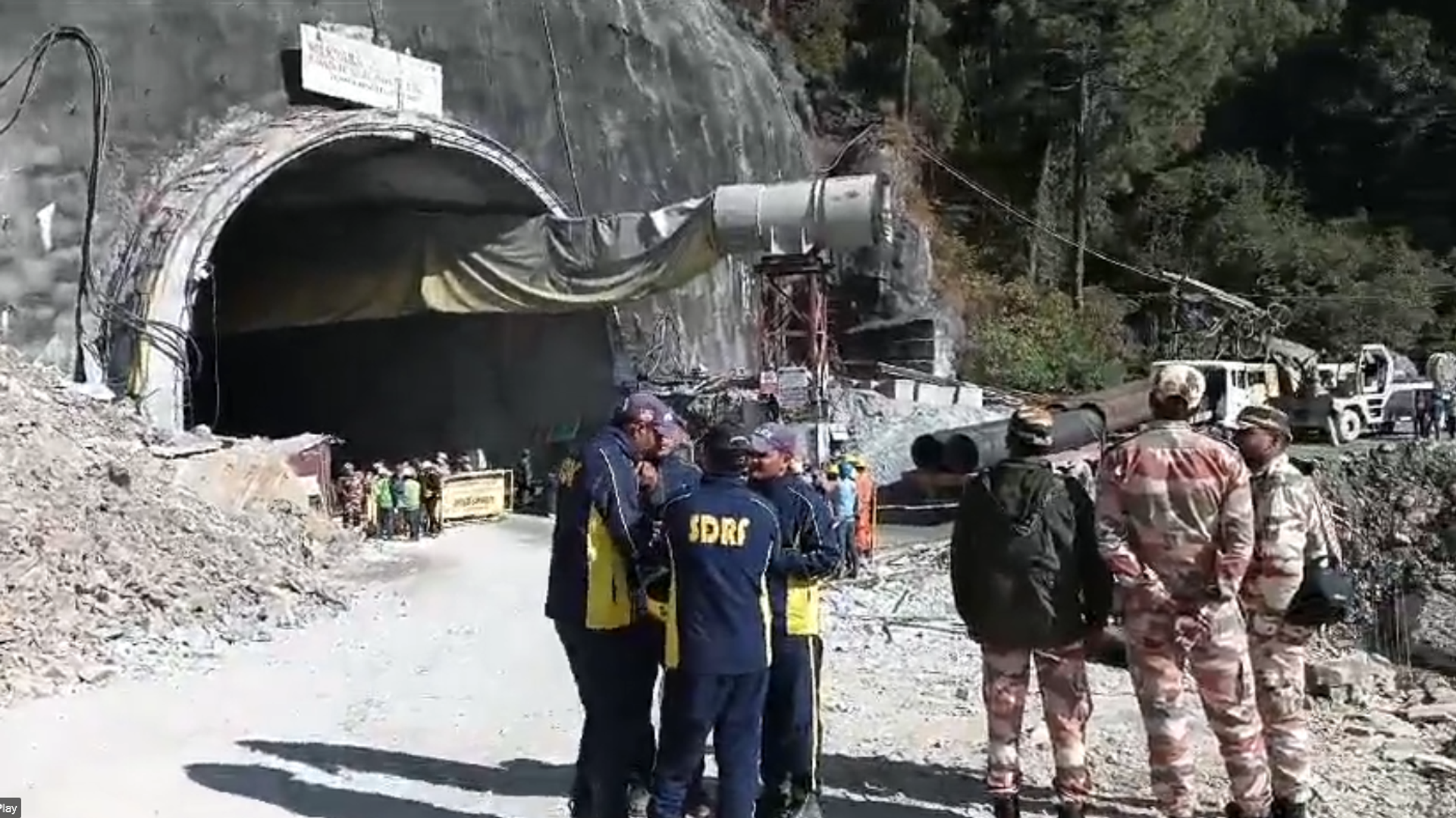https://sputniknews.in/20231129/lessons-to-be-learnt-from-uttarakhand-tunnel-operation-5625670.html
Lessons To Be Learnt from Uttarakhand Tunnel Operation
Lessons To Be Learnt from Uttarakhand Tunnel Operation
Sputnik India
All 41 workers were safely rescued from the incomplete Barkot-Silkyara tunnel after 400 hours - 17 days - on Tuesday evening. Sputnik India spoke with experts... 29.11.2023, Sputnik India
2023-11-29T13:26+0530
2023-11-29T13:26+0530
2023-11-29T21:06+0530
india
uttarakhand
the himalayas
us
rescue operation
disaster relief
natural disaster
landslide
silkyara tunnel
national disaster response force (ndrf)
https://cdn1.img.sputniknews.in/img/07e7/0b/0e/5400471_7:0:1410:789_1920x0_80_0_0_6f5d86f05bf7c810979bf8f5ceeb1481.png
On 12 November, after a landslide, the tunnel's 200-metre entrance was blocked with rocks, concrete stone, and metal, after which the Indian authorities launched a massive rescue operation.However, authorities faced several challenges while drilling the remaining 60-meter stretch of rubble. As a result, the operation was delayed after the regular drilling machine broke and then the US auger machine was installed, however, on 24 November, its blade too broke beyond repair, finally, the debris was removed manually. Challenges Faced By Authorities While DrillingAs the machine keeps failing to do its job in the Himalayan region, the expert also said that there won't be more drilling with machines, they will look for alternate options.The final work was carried out manually, in which drilling is done by 'rat miner,' a method used to drill narrow shafts as part of a primitive method of coal extraction.Volatile Ecology of the HimalayasProfessor C.P. Chandran opined that the Main Central Thrust (MCT) tectonic fault line along the Himalayas poses a risk to the construction of roads and tunnels in the region."Some rocks are soft, some are hard, creating stability issues in the region… This is not the first time we have seen such an incident. We are constantly witnessing disaster," Rajendran said.The professor opined that before starting construction at volatile range, generally, geology and rock composition detailed examination should be done. Ignoring the region's geology could lead to dangerous accidents. India Takes ActionThe Silkyara tunnel is part of a $1.5bn, 890km-long Char Dham road project, which will connect four Hindu pilgrims, Badrinath, Kedarnath, Gangotri and Yamunotri in the Uttarakhand.Following this incident, the National Highways Authority of India (NHAI) said that it will carry out a safety audit of 29 tunnels under construction tunnel, which includes 12 tunnels in the Himalayan state of Himachal Pradesh, six in the Jammu and Kashmir region, and the rest in other states including Uttarakhand.
https://sputniknews.in/20231128/uttarakhand-tunnel-operation-enters-its-final-stage-5616250.html
india
uttarakhand
the himalayas
us
Sputnik India
feedback.hindi@sputniknews.com
+74956456601
MIA „Rossiya Segodnya“
2023
Deexa Khanduri
https://cdn1.img.sputniknews.in/img/07e6/0c/13/138923_52:0:533:481_100x100_80_0_0_cadf23d341691fc65ff2b22fd1afe584.jpg
Deexa Khanduri
https://cdn1.img.sputniknews.in/img/07e6/0c/13/138923_52:0:533:481_100x100_80_0_0_cadf23d341691fc65ff2b22fd1afe584.jpg
News
en_IN
Sputnik India
feedback.hindi@sputniknews.com
+74956456601
MIA „Rossiya Segodnya“
Sputnik India
feedback.hindi@sputniknews.com
+74956456601
MIA „Rossiya Segodnya“
Deexa Khanduri
https://cdn1.img.sputniknews.in/img/07e6/0c/13/138923_52:0:533:481_100x100_80_0_0_cadf23d341691fc65ff2b22fd1afe584.jpg
uttarakhand tunnel operation enters final stage, uttarakhand tunnel collapse, uttarkashi tunnel rescue, rat miners, uttarakhand tunnel collapse, uttarkashi tunne collapse, how tunnel collapased, uttarkashi tunnel, silkyara-barkot tunnel in uttarkashi, trapped workers, silkyara tunnel, uttarkashi tunnel, rescue operation in uttarakhand, ndrf, sdrf, ndma, ministry of road transport and highways, 41 workers trapped in uttarakhand tunnel, auger machine, arnold dix, international tunneling expert, rescue operation
uttarakhand tunnel operation enters final stage, uttarakhand tunnel collapse, uttarkashi tunnel rescue, rat miners, uttarakhand tunnel collapse, uttarkashi tunne collapse, how tunnel collapased, uttarkashi tunnel, silkyara-barkot tunnel in uttarkashi, trapped workers, silkyara tunnel, uttarkashi tunnel, rescue operation in uttarakhand, ndrf, sdrf, ndma, ministry of road transport and highways, 41 workers trapped in uttarakhand tunnel, auger machine, arnold dix, international tunneling expert, rescue operation
Lessons To Be Learnt from Uttarakhand Tunnel Operation
13:26 29.11.2023 (Updated: 21:06 29.11.2023) Deexa Khanduri
Sputnik correspondent
All 41 workers were safely rescued from the incomplete Barkot-Silkyara tunnel after 400 hours - 17 days - on Tuesday evening. Sputnik India spoke with experts to discover why the rescue operation took so long.
On 12 November, after a landslide, the tunnel's 200-metre entrance was blocked with rocks, concrete stone, and metal, after which the Indian authorities launched a massive rescue operation.
However, authorities faced several challenges while drilling the remaining 60-meter stretch of rubble. As a result, the
operation was delayed after the regular drilling machine broke and then the
US auger machine was installed, however, on 24 November, its blade too broke beyond repair, finally, the debris was removed manually.
Challenges Faced By Authorities While Drilling
"The rescue operation at Himalayan is tricky. This is not a straightforward drill. The mountains are young, and if one tries to drill it forcefully, one may find an unknown water spring, which can flood or devastate the situation," C.P. Rajendran, geologist and Adjunct Professor at the National Institute of Advanced Studies, told Sputnik India.
As the machine keeps failing to do its job in the Himalayan region, the expert also said that there won't be more drilling with machines, they will look for alternate options.
".. You will not see the Augering anymore. Auger is finished. The drill (machine) has broken. It's irreparable. No more work from auger. No more drilling from the auger. There will not be a new drill," said tunneling expert Arnold Dix, who is especially called for the operation on Friday (November 24).
The final work was carried out manually, in which drilling is done by 'rat miner,' a method used to drill narrow shafts as part of a primitive method of coal extraction.
Volatile Ecology of the Himalayas
Professor C.P. Chandran opined that the Main Central Thrust (MCT) tectonic fault line along the Himalayas poses a risk to the construction of roads and tunnels in the region.
"The construction near areas like Silkyara tunnel which is close to the MCT fault line will always be risky," the professor said, adding, "rocks in the Himalayan region varied and had different strengths."
"Some rocks are soft, some are hard, creating stability issues in the region… This is not the first time we have seen such an incident. We are constantly witnessing disaster," Rajendran said.
The professor opined that before starting construction at volatile range, generally, geology and rock composition detailed examination should be done.
Ignoring the region's geology could lead to dangerous accidents.
"Government needs to learn lessons from the incident, and the
whole project should emerge as a catalyst for a sustainable and harmonious coexistence between development and nature,"
Vimlendu Jha, an environmentalist & the founder of Swechha told Sputnik India.The Silkyara tunnel is part of a $1.5bn, 890km-long Char Dham road project, which will connect four Hindu pilgrims, Badrinath, Kedarnath, Gangotri and Yamunotri in the
Uttarakhand.
Following this incident, the National Highways Authority of India (NHAI) said that it will carry out a safety audit of 29 tunnels under construction tunnel, which includes 12 tunnels in the Himalayan state of
Himachal Pradesh, six in the
Jammu and Kashmir region, and the rest in other states including Uttarakhand.



